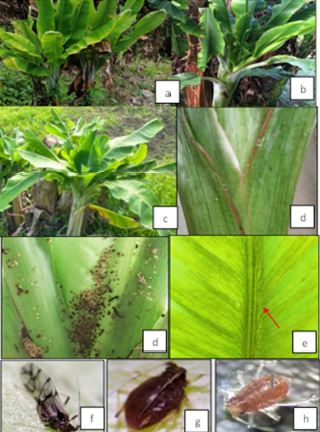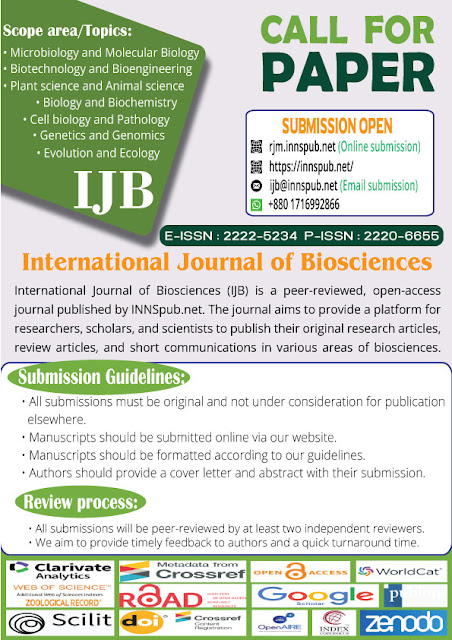Angelina T. Gonzales, Diosa G. Alasaas, and Ricardo B. Casauay, from the different institute of the Philippines. wrote a research article about, Banana Bunchy Top Disease: First Report in Cagayan Valley, Philippines, entitled, First report of Banana bunchy top disease (BBTD) on Banana (Saba variety) in Cagayan Valley Region, Philippines. This research paper published by the Internatioal Journal of Biosciences | IJB. an open access scholarly research journal on Biology, under the affiliation of the International Network For Natural Sciences | INNSpub. an open access multidisciplinary research journal publisher.
Abstract
The study on the occurrence and symptomatology of banana bunchy top disease (BBTD) was conducted to determine the occurrence and study the symptoms and associated signs that characterized BBTD in the banana farms in the province of Cagayan, Philippines. A survey and mapping were used to the major banana growing municipalities namely: Allacapan, Lasam, Gattaran and Baggao, in the province of Cagayan, North-eastern part of the Philippines. The data were analyzed using the frequency counts, weighted means, and percentages. The geo-referenced locations of the banana farms were analyzed using the QGIS software. BBTD – infected plants were described, occurrence was mapped and associated insect vector was investigated Results revealed that the most observable symptoms in the field involved stunting, ragged margins, upturned leaves, chlorotic reducing lamina width, petiole length and distance of the leaves. The whole growing banana plants may grow but obviously resulting to stunting. Banana crops that are infected with BBTV in the vegetative phase will not produce fruit. Black aphids (Pentalonia nigronervosa) are found always associated with the banana plants and thus transmit the virus. Ocurrence of BBTD was determined in September 2020 to September 2021 at Allacapan, Lasam, Gattaran and Baggao, Cagayan barangays/locations while typical symptoms of BBTD were first observed in all of the banana growing locations in the province of Cagayan, Philippines. Symptomatology and association of aphids confirmed the presence of BBTD. This is thought to be the first report of BBTD on banana (Musa spp.) in the province of Cagayan, Philippines.
Introduction
In the Philippines, banana is one of the most important fruit crops (Damasco et al., 2019). In Cagayan Valley, banana is the prime commodity under fruit crops. Like, any important crop, banana is attacked by pests and diseases. To date, the most devastating virus disease affecting yield losses of banana plantations in Africa, the South Pacific, and Asia, like the Philippines, is the banana bunchy top disease (BBTD) caused by the Banana bunchy top virus (BBTV). However, the incidence and distribution of BBTD have never been reported in Cagayan Valley Region, Philippines. From 2010 to 2012, the Philippine production of banana with more than 9.2 million metric tons, followed by a sharp decline in 2013 as a direct result of the damage wrought by typhoon Pablo. In terms of area planted, from a high of about 454,000 hectares in 2012, this declined to about 446,000 hectares is 2013 and further down to 443,000 hectares in 2014 and 2015 (PSA, 2014-2017). The most significant commercial production are located in Davao Region in Mindanao and Cagayan Valley in Luzon.
In Cagayan Valley, banana is the prime commodity under fruit crops. During the first quarter of 2019, the production was pulled down by 45.48%, with a shortage of 15,680 metric tons from 2018 of 34,481 metric tons due to super typhoons Ompong and Rosita in second semester of 2018 (PSA, 2019). Aside from the typhoon, other factors, such as changing weather patterns, pests, and diseases, affect the production of bananas. One of the significant constraint diseases is the banana bunchy top disease.
Banana bunchy top disease (BBTD) caused by the banana bunchy top virus (Babuvirus, Nanoviridae) is one of the most economically important diseases of bananas in many production regions of the world, including the Philippines (Dale, 1987). Banana plants can only be infected from (1) infected plant materials and (2) the banana aphid when carrying the virus. When people give away young banana plants or suckers to others, the BBTV can spread (Johansen, K et al., 2014).
The virus is transmitted in a persistent and circulative but non-propagative manner by the banana aphid, Pentalonia nigronervosa (Hafner et al., 1995, Hu et al., 1996). The aphid is a tiny black insect that, once feeding on an infected banana plant, becomes a carrier of the BBTV. The wind can carry many kilometers of aphids, which may further spread the BBTV. Hook et al., showed that the incubation period of BBTV or the appearance of symptoms in banana plants ranged from 25 to 85 days after aphid inoculation (Johansen, K et al., 2014). Initial symptoms in infected plants include marginal chlorosis, dark green dots, and streaks along the veins that often extend down the midrib and petiole. Infected plants become progressively stunted with malformed and more upright leaves, eventually resulting in a ‘bunchy’ appearance. Plants infected early with BBTV do not bear fruit, and fruits of later infected plants are typically deformed and unmarketable.
Hence, yield losses in severely infected plants can be as high as 100%. The virus is systemic, meaning that the disease is transmitted from the infected mother plant to subsequent suckers, and eventually, the whole mat dies (Hong-Ji, 2000b). Additionally, the virus spreads to suckers through the rhizome, and the entire banana mat eventually becomes infected (Dale and Harding 1998). It has been reported that the rate of BBTV re-infection in the field ranges from 5% in well-managed farms to 20% and 75% in medium- and traditionally-managed farms, respectively (Magnaye and Espino, 1990).
This study deals with the occurrence of the banana bunchy top in the major banana-producing areas in Cagayan province using GIS. Through GIS, it can capture, store, check, and display data related to positions on Earth’s surface. GIS can show many different kinds of data in one map, enabling people to see, analyze, and understand patterns and relationships (Gonzales A.T. et al., 2018). Since this research determined the distribution of BBTD in Cagayan province, the use of GIS is deemed needed.
Generally, this study determined the occurrence and distribution of banana bunchy top disease (BBTD) in banana plantations in Cagayan province, specifically in the municipalites of Allacapan, Lasam, Gattaran and Baggao using Geographic Information System (GIS). Specifically it aimed to determine the distribution and prevalence of BBTD and examine, describe, and document the BBTD symptoms from BBTD banana plantations in the Cagayan province.
Reference
Aspinall R. 1992.
Inductive modelling procedure based on Bayes’ theorem for analysis of pattern
in spatial data. International Journal of Geographical Information
Science 6, 105-121.
Dale JL. 1987.
Banana bunchy top: An economically important tropical plant virus disease.
Advance in Virus Research 33, 301-325.
Ferreira SA, Trujillo
EE, Ogata DY. 1997. Banana bunchy top Virus. College of Tropical
Agriculture & Human Resources University of Hawaii at Manoa (CTHR)
available online: http://www. cthr .
hawwai .edu/co/freepubs/pdf/PD-12.pdf.
Gonzales AT, Sawadan
RD, Flores A. 2018. Cacao mapping using Geographic Information System
(GIS) in the Province of Cagayan, Philippines. Journal of Biodiversity and
Environmental Sciences (JBES) ISSN: 2220-6663 (Print) 2222-3045 (Online) 13(2), 381-386,
2018 http://www. innspub.net
Guisan A, Theurillat
JP, Kienast F. 1998. Predicting the Potential Distribution of Plant
Species in an Alpine Environment. Journal of Vegetation Science 9, 65-74.
Johansen K, Sohlbach
M. 2014. Mapping banana plants from high spatial resolution orthophotos to
facilitate plant health assessment.
Karnataka GU, Prema KT,
Rangaswamy, Pruthvi TPM. 2012. Multiplex polymerase chain reaction
technique for simultaneous detection of the Banana streak virus (BSV) and
Cucumber mosaic virus (CMV) in banana from Karnataka. Current Biotica 6(2), 141-151
Kiranmai G,
Lavakumar P, Hema M, Venkatramana M, Kirshnaprasadji J, Mandheva R,
Sreenivasalu P. 2005. Partial characterization of a potyvirus causing
bract mosaic of banana in Andhra Pradesh. Indian J. Virol 16, 7-11.
Leathwick JR, Rowe D,
Richardson J, Elith J, Hastie T. 2005. Using multivariate adaptive
regression splines to predict the distributions of New Zealand’s freshwater
diadromous fish. Freshwater Biology 50, 2034-2052.
Magee CJP. 1940a.
Transmission of infectious chlorosis or heart rot of banana and its
relationship to cucumber mosaic. Journal of the Australian Institute of
Agriculture 6, 44-47.
Magnaye LV, Espino
RR. 1990. Banana bract mosaic, a new disease of banana. I. Symptomatology.
Philipp. Agric 75, 55-59.
Selvarajan
R, Balasubramanian V. 2014. Host–virus interactions in
banana-infecting viruses. www.philmech.gov.ph Banana: Postharvest situationer
Source : First report of Banana bunchy top disease (BBTD) on Banana (Saba variety) in Cagayan Valley Region, Philippines











%20in%20full.JPG)


0 comments:
Post a Comment